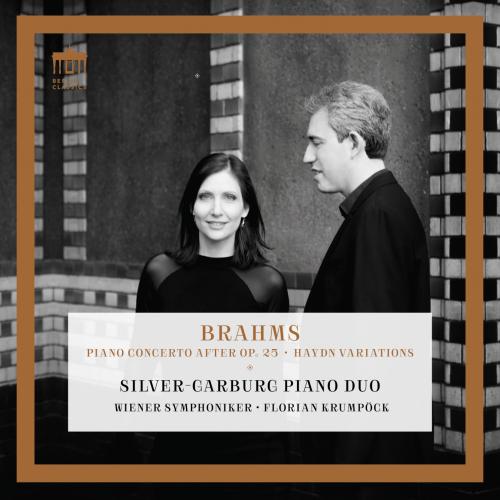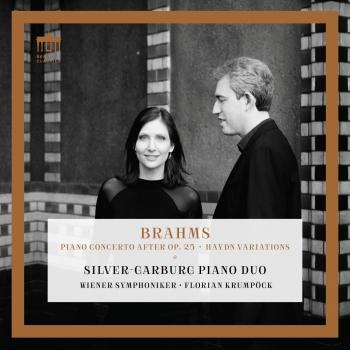
Album info
Album-Release:
2020
HRA-Release:
09.10.2020
Label: Berlin Classics
Genre: Classical
Artist: Silver Garburg Piano Duo & Wiener Symphoniker
Composer: Johannes Brahms (1833-1897)
Album including Album cover
- Johannes Brahms (1833 - 1897): Concerto for Piano Four Hands and String Orchestra in G Minor (After the Quartet, Op. 25):
- 1 Concerto for Piano Four Hands and String Orchestra in G Minor (After the Quartet, Op. 25): I. Allegro 13:08
- 2 Concerto for Piano Four Hands and String Orchestra in G Minor (After the Quartet, Op. 25): II. Allegro ma non troppo 07:49
- 3 Concerto for Piano Four Hands and String Orchestra in G Minor (After the Quartet, Op. 25): III. Andante con moto 10:28
- 4 Concerto for Piano Four Hands and String Orchestra in G Minor (After the Quartet, Op. 25): IV. Rondo alla Zingarese: Presto 08:48
- Variations on a Theme by Joseph Haydn, Op. 56b:
- 5 Variations on a Theme by Joseph Haydn, Op. 56b: Thema. Chorale St. Antoni: Andante 02:15
- 6 Variations on a Theme by Joseph Haydn, Op. 56b: Variation I. Andante con moto 01:14
- 7 Variations on a Theme by Joseph Haydn, Op. 56b: Variation II. Vivace 01:02
- 8 Variations on a Theme by Joseph Haydn, Op. 56b: Variation III. Con moto 02:03
- 9 Variations on a Theme by Joseph Haydn, Op. 56b: Variation IV. Andante 02:07
- 10 Variations on a Theme by Joseph Haydn, Op. 56b: Variation V. Poco presto 00:54
- 11 Variations on a Theme by Joseph Haydn, Op. 56b: Variation Vi. Vivace 01:16
- 12 Variations on a Theme by Joseph Haydn, Op. 56b: Variation VII. Grazioso 02:54
- 13 Variations on a Theme by Joseph Haydn, Op. 56b: Variation VIII. Poco Presto 00:56
- 14 Variations on a Theme by Joseph Haydn, Op. 56b: Finale. Andante 03:52
Info for Brahms
Music by Johannes Brahms for four hands would be nothing out of the ordinary as a recital programme given by the renowned Silver Garburg piano duo – but a concert featuring piano four hands with orchestra? The versatile Austrian composer and arranger Richard Dünser has arranged Brahms’s Piano Quartet op. 25 and dedicated the resultant work to his friends of many years Sivan Silver and Gil Garburg. This is a very special piece of music with an exciting genesis.
True, there is already a version of the Piano Quartet op. 25 for orchestra by Arnold Schoenberg and Johannes Brahms composed a four-handed version himself, but not in the form of a piano concerto. So it was a special challenge for arranger Richard Dünser to prepare the work in a completely new and unfamiliar scoring, drawing on both the earlier versions in the process. “This is all absolutely nothing like a scientific or philological exercise; ultimately, I went to work on the original as if it was my own, and I had the courage to do things that a mere arranger would never dare do,” says Richard Dünser himself of his piece. “It was a stroke of luck at this premiere recording that I could be present and interact with the Silver Garburg Piano Duo and the Vienna Symphony, all of whom are perfectly at home with music in the Classical-Romantic tradition and with my own music, so as to exchange concepts and ideas and feed the sum of this interaction into the recording.”
For Sivan Silver and Gil Garburg themselves, it was an adventure to be recording this new arrangement. The interpretation of a new work is always an amazing, creative process: “We have great respect for the composer and the musical text. That represents a great responsibility, especially in the case of a new piece. We as its interpreters see it as one of our principal aims to move each listener and accompany him and her on their musical journey. The promise extended by a newly heard work and the curiosity that it arouses excites and involves the exponents as much as their audience. That is what keeps the music experience alive and constantly relevant.” Nor was this piece a matter of coincidence. Sivan Silver and Gil Garburg were actively investigating the possibility of playing a concerto suited to their instrumental configuration. After a long search, arranger and piano duo settled on this piano quartet; the present arrangement is the result. It was recorded in December 2018 in the city that Brahms made his home: “Recording the Brahms concerto in the heart of Vienna, in the city’s Konzerthaus, together with the Vienna Symphony Orchestra under the baton of Viennese conductor Florian Krumpöck, was something we perceived not only as an appropriate, natural choice, but also as a thrilling challenge and a commitment to tradition that we have met with delight.”
The CD also features an “original” work by Brahms. His Haydn Variations are among the most important Romantic works for two pianos and show that Brahms greatly valued this scoring. He took as his model the Divertimento in B flat major for winds, which interestingly enough is not “original Haydn” at all. Modern musicological research shows the theme to have been based on an early pilgrim song dating from before Haydn’s time. Not that Brahms was aware of that. He wrote a set of eight “Variations on a theme of Joseph Haydn for two pianos in B flat major” op. 56b, also known as the St. Antoni Variations.
Sivan Silver, piano
Gil Garburg, piano
Piano Duo Silver Garburg
In the great and often underappreciated art of piano duo playing, Sivan Silver and her partner Gil Garburg are setting a new standard: acclaimed by audiences and critics alike, the duo has been invited time and time again by top orchestras, festivals, and concert organizers. They have performed in Carnegie Hall, Lincoln Center, the Vienna Musikverein, the Salzburg Festspielhaus, the Sydney Opera House, and the Berlin Philharmonie; they have concertized in approximately 70 countries on five continents; and they collaborate regularly with such orchestras as the Israel Philharmonic, the St. Petersburg Philharmonic, the Melbourne Symphony, and the Deutsche Kammerphilharmonie.
In 2014, the Graz University for the Arts unanimously chose the Silver-Garburg Duo to occupy one of the few extant professorships for piano duo. Previously, they taught at the Hannover Musikhochschule, the elite German piano school at which they themselves completed their studies in 2007 under Arie Vardi.
Their recording of Mendelssohn's concertos for two pianos and orchestra, with the Bavarian Chamber Philharmonic under Christopher Hogwood, has been called "breathtaking" (Bayerische Rundfunk) and "extremely exciting” (Süddeutsche Zeitung). Their latest album with Stravinsky ballets has been described as "grandiose" (Pizzicato, Supersonic award) and "thrilling" (Fono Forum, CD of the Month). The Frankfurter Allgemeine Zeitung raved about the "lyrical sensitivity and the ravishing technical mastery" of the duo, noting that only rarely does one experience "such spontaneous shouts of 'bravo'" at the end of a concert. The Independent concluded: "What a wondrous evening!"
A very special current project of the two Israelis living with their son in Berlin is a Brahms concerto based on the Piano Quartet in G minor. The Austrian composer Richard Dünser, with whom they closely collaborate, has successfully and exclusively transcribed the concerto based on two original versions by Brahms himself for piano, four hands, and string orchestra. They not only play this outstanding program with orchestras in Berlin, Vienna, Jerusalem, Bratislava, Spokane, Klagenfurt, Tel Aviv and Bremen but also release it as a world premiere recording with the Wiener Symphoniker on the Berlin Classics label.
After 20 years of playing together, Sivan Silver and Gil Garburg are establishing themselves at the top echelon of the music world. "As a piano duo, it’s easy to make effects with virtuosity. But that alone is far too little. We want to move our listeners emotionally and bring them to the core of the music".
This album contains no booklet.












